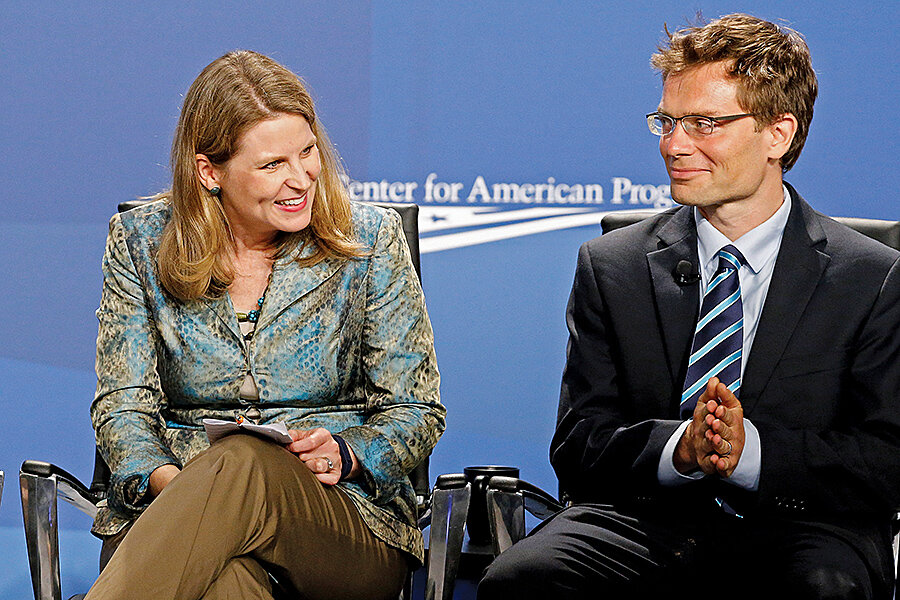Breaking the cement ceiling of trade unions
Loading...
| Washington
In 2009, Liz Shuler became secretary-treasurer of the AFL-CIO, the highest-ranking woman in the history of the largest labor federation in the United States.
As a member of Generation X, Ms. Shuler also represented the labor movement’s effort to reach into a younger cohort of workers – as well as to women, both in building union ranks and as leaders. At a recent Monitor breakfast, AFL-CIO president Richard Trumka described women as being “by nature more collaborative.” He singled out Shuler as an example of someone who “listens to what people have to say, and then she makes a sharp decision.”
We spoke with Shuler recently about her career and the future of women in the labor movement. Here are excerpts, edited for clarity:
Q: Tell me your background as a union organizer.
I came up through the IBEW, the International Brotherhood of Electrical Workers – the sisterhood’s implied. I started out as an organizer in my local union at Portland General Electric, in Oregon.... I was organizing clerical workers.... We lost that election, but that’s when I found my passion for organizing, and I ended up going to work for the local union anyway. I was the only woman on staff.
Q: What was that like?
I was 23, blond, female, definitely unusual. The others were mainly power linemen, construction linemen, and folks who had come up through the ranks. All men. That was my first experience – dealing with how to be taken seriously (a) as a woman and (b) as a young person. It was pretty rough and tumble when I first got started.
Q: Did your male colleagues help you?
My entire career I’ve had male mentors, because there have not been a lot of women leaders.
Q: It sounds as if you had some pretty progressive men willing to mentor a young woman.
It was a mixed bag. I certainly had my share of sexual harassment and dealing day to day with the comments.... You do work twice as hard to be on par with your male counterparts. But for every guy who made a dismissive or hostile comment, there would be another that would be encouraging and saying, “We need more people like you in this labor movement.”
Q: Why was that?
I think it was a recognition that women approach things differently. I think Rich [Trumka] had said that we’re better listeners, we’re better collaborators, and it sounds stereotypical, but at the same time those are strengths we bring to the table.... I don’t know if it’s machismo or testosterone or whatever, but men tend to have a more aggressive or confrontational style, and I would say women are more naturally trying to be solutions-driven and bring people together.
Q: Where do women stand in the labor movement?
Women are nearly half the workforce ... and in less than 10 years, the labor movement will be half women.... The sectors of the economy that are growing are predominantly female-staffed – health care, service, and retail. Certainly, we have concerns about the nature of the low-wage economy and the role that women play in that.
Q: What about women in labor leadership? It is said that, for women to make a difference, you need a critical mass – 20 to 30 percent.
That is the advice we often find ourselves giving women in the labor movement who find themselves in the minority or outnumbered: Find a way to organize either other women, to bring it to critical mass, or men who will stand up....
The more numbers we find ourselves getting, the stronger [we] feel. That’s the whole foundation of the labor movement. It’s the collective voice, the idea that more voices together bring more power. The fundamentals really do hold true, especially for women.
Q: Have there been any strong examples recently of women as effective labor negotiators?
My good friend Cindy Estrada, vice president of the United Auto Workers, was the first woman put in charge of the General Motors part of the union. So she was the chief negotiator of the [2015] contract, and the first woman in that role – with a woman at the helm of the company, Mary Barra. It’s a really compelling story. They brought a totally different style to the table, and were able to work things out in a way that had never been done before.






